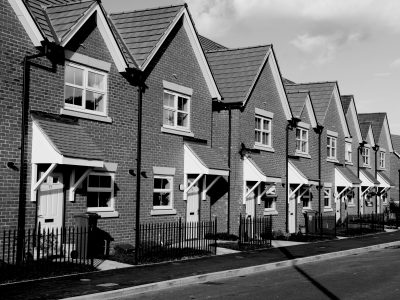Research by the estate agent comparison site, GetAgent.co.uk, has found that homebuyers across Britain now face a considerably tougher task when it comes to climbing the ladder, as heightened market activity due to the stamp duty holiday has caused a significant jump in the average income to house price ratio.
GetAgent analysed data on both house price and the average income across Britain, looking at how the income to house price ratio has changed since the property tax reprieve was launched last July.
Income to house price ratio climbs to 8.1 in Britain
The data shows that the average person in Britain earns a gross income of £31,770. Back in July, the average property price in Britain was £239,355.
This placed the income to house price ratio at 7.5 – essentially meaning that it would take 7.5 years of the average gross income to fully cover the cost of the average property.
However, since then the latest available data for May of this year shows that house prices have climbed to an average of £257,726 across Britain, pushing the average income to house price ratio up to 8.1 – a 0.6% increase in less than a year.
Interestingly, while the average income to house price ratio differs across Wales, Scotland and England, all three nations have also seen a 0.6 increase, despite also seeing their respective SDLT holidays run for varying periods of time.
South East sees the largest regional jump
All regions of Britain have seen an uplift in the income to house price ratio since the launch of the stamp duty holiday.
The South East has seen the largest regional jump, up 0.7 from 9.3 in July of last year. This means that the average home in the region now costs ten times that of the average gross income.
While London is home to the largest current ratio at 11.7, the region has, at least, seen the smallest increase, up by just 0.3 since July 2020.
Rutland, North Devon and South Hams home to the highest increases
The bad news is that in many local authorities, this increase has been far greater and nowhere more so than Rutland.
In July 2020, the average home in the region required 10.4 years of gross income to cover but today, this has climbed to 12.7 – a 2.3 increase.
North Devon (+2.2), South Hams (+2.2) and West Devon (+2.0) have also seen the average income to house price ratio climb by more than +2 in less than a year.
Richmondshire (+1.9), Oxford (+1.8), North Norfolk (+1.8), Wychavon (+1.7), Mole Valley (+1.6) and Cotswolds (1.6) also rank within the top 10 areas to see the biggest hit to house price affordability as a result of the stamp duty holiday.
Founder and CEO of GetAgent.co.uk, Colby Short, commented:
“Much like most government initiatives to stimulate the housing market, a short term focus on house price prosperity is starting to leave a legacy of long market delays, disgruntled homebuyers and some of the worst levels of housing affordability we’ve seen in recent times.”
“While it may be accepted that some areas of Britain are home to far higher property values and therefore require a far greater level of earnings, to see this ratio increase so notably across the board, and in less than a year, really highlights the tough task facing today’s aspirational homeowners.”
| Table shows the change in income to house price ratio since the launch of the stamp duty holiday and currently (May 2021 – latest available data) | ||||||
| Location | Average annual gross salary (2020) | AveHP – July 2020 | AveHP – May 2021 | Affordability ratio July 2020 | Affordability ratio May 2021 | Change in affordability ratio |
| South East | £35,039 | £325,592 | £350,016 | 9.3 | 10.0 | 0.7 |
| North West | £28,644 | £171,139 | £189,245 | 6.0 | 6.6 | 0.6 |
| Wales | £26,805 | £168,415 | £184,297 | 6.3 | 6.9 | 0.6 |
| Scotland | £29,980 | £154,553 | £171,448 | 5.2 | 5.7 | 0.6 |
| West Midlands Region | £29,408 | £203,616 | £219,793 | 6.9 | 7.5 | 0.6 |
| East Midlands | £28,957 | £200,418 | £216,077 | 6.9 | 7.5 | 0.5 |
| East of England | £33,114 | £292,517 | £310,200 | 8.8 | 9.4 | 0.5 |
| South West | £28,003 | £263,831 | £277,603 | 9.4 | 9.9 | 0.5 |
| North East | £27,153 | £130,713 | £143,129 | 4.8 | 5.3 | 0.5 |
| Yorkshire and The Humber | £28,096 | £169,056 | £181,856 | 6.0 | 6.5 | 0.5 |
| London | £42,667 | £483,267 | £497,948 | 11.3 | 11.7 | 0.3 |
| England | £32,237 | £253,257 | £271,434 | 7.9 | 8.4 | 0.6 |
| Great Britain | £31,770 | £239,355 | £257,726 | 7.5 | 8.1 | 0.6 |
| Average house prices sourced form the Gov.uk – UK House Price Index (July 2020 to May 2021 – latest available data) | ||||||
| Average salary data sourced from ONS – Employee earnings in the UK (2020 – latest available data) | ||||||
| Income to house price ratio based on the average house priced divided by the average gross income | ||||||
| Table shows the areas to have seen the biggest change in income to house price ratio since the launch of the stamp duty holiday (May 2021 – latest available data) | ||||||
| Location | Average annual gross salary (2020) | AveHP – July 2020 | AveHP – May 2021 | Affordability ratio July 2020 | Affordability ratio May 2021 | Change in affordability ratio |
| Rutland | £30,402 | £316,644 | £385,684 | 10.4 | 12.7 | 2.3 |
| North Devon | £22,025 | £237,552 | £286,342 | 10.8 | 13.0 | 2.2 |
| South Hams | £24,354 | £299,549 | £353,318 | 12.3 | 14.5 | 2.2 |
| West Devon | £28,380 | £249,541 | £306,203 | 8.8 | 10.8 | 2.0 |
| Richmondshire | £23,750 | £208,812 | £255,058 | 8.8 | 10.7 | 1.9 |
| Oxford | £31,232 | £399,238 | £455,537 | 12.8 | 14.6 | 1.8 |
| North Norfolk | £23,274 | £246,718 | £288,125 | 10.6 | 12.4 | 1.8 |
| Wychavon | £29,055 | £273,541 | £322,181 | 9.4 | 11.1 | 1.7 |
| Mole Valley | £36,879 | £474,266 | £534,969 | 12.9 | 14.5 | 1.6 |
| Cotswold | £32,585 | £391,212 | £443,022 | 12.0 | 13.6 | 1.6 |
| Average house prices sourced form the Gov.uk – UK House Price Index (July 2020 to May 2021 – latest available data) | ||||||
| Average salary data sourced from ONS – Employee earnings in the UK (2020 – latest available data) | ||||||
| Income to house price ratio based on the average house priced divided by the average gross income | ||||||

























Comments